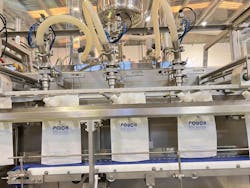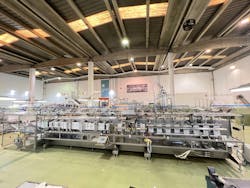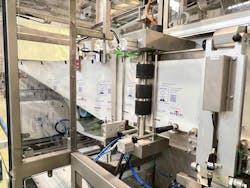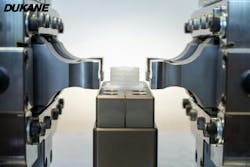Machine, welding modifications lead to greener stand-up pouch for Effytec
Key Highlights
- Stand-up pouches use less material than rigid containers but face recycling challenges due to multi-layer films and spouts of different materials.
- Collaborative development has resulted in a retrofittable machine setup capable of producing mono-material, recyclable pouches with integrated spouts.
- Innovative welding technology, including dual ultrasonic welders, enables precise sealing of temperature-sensitive, recyclable films without damage.
- Advances in extrusion and film composition reduce barrier material content, making recycling more feasible and environmentally friendly.
- Widespread adoption of these greener pouches could reduce landfill waste and meet increasing consumer demand for sustainable packaging solutions.
Problem: Stand-up pouches use less material than rigid containers, but their spouts and material composition make recycling difficult.
Solution: Retrofits to a form-fill-seal machine and modifications to a welding process allow manufacturing of a greener alternative.
By Karen Hanna
There’s a lot more to recycling than simply throwing every plastic package in the bin and hoping for the best.
To make spouted pouches for the circular economy, a group of equipment and packaging makers came together to move beyond wish-cycling, and developed both a new packaging and the machinery cell — complete with welding automation — to produce it.
In an interview involving some of the partners, Effytec USA President Roger Stainton described the vision: “We’ve got to build a spouted pouch machine that can run recyclable film, and we’ve got to take it to the market.”
Stand-up pouches use less material than rigid containers, and while neither packaging format is consistently recycled, pouches take up less landfill space.
Unfortunately, most pouches have multiple layers and a spout of a different material — a potpourri of materials that forecloses on the possibility of recycling. On the other hand, all those layers make them easier to manufacture.
A couple years ago, that paradox — between the ease of manufacturing and the difficulty of remanufacturing — drew together a handful of companies in a project to develop a greener alternative. Along with Effytec, a De Pere, Wis., maker of form-fill-seal machinery, participants included flexible packaging maker LD Pack USA; St. Charles, Ill., welding equipment maker Dukane Corp.; and South Elgin, Ill., molder Hoffer Plastics.
Together, they’ve created a retrofittable setup that’s now production-ready and in use on three machines in Europe.
Films, spouts create material disadvantages
The difficulties of manufacturing a greener package underscore the importance of the collaboration. Both the materials the partners chose and the process of attaching a spout presented complications.
“Historically, the industry has been challenged in finding an affordable, efficient solution to seal mono-material films due to the complexities associated with films, spouts and standard sealing processes — including heat sealing and ultrasonic welding,” Stainton said.
While not in wide use in the U.S., stand-up pouches are popular in many other regions, including Canada, where people buy their milk in bags. Elsewhere, especially in Asia and Eastern Europe, the shelves of stores are filled with goods of all varieties sealed in bags— cereal, detergent and soap, fertilizer, motor and cooking oil, ketchup, yogurt, baby food, and milk and other beverages.
Because of what’s inside, some of those bags have special material needs.
Rick Pindur, director of packaging solutions and market development for LD Pack, which supplies film for the pouch project, said one challenge has been to reduce the composition of barrier materials in film, so that it can be recycled. With extrusion advances, film makers can now produce film with such a small percentage of secondary materials, they can be processed in a mono-recycling stream.
“Traditional technologies had huge variation in extruding materials, where you could see 20, 30 percent variation in gauge thickness. But the newest technologies have more layers, more precise control, so you can make a barrier film and control how much of the undesirable materials that aren’t easily recyclable [are used]. So, you can put such a small amount, get the barrier, but when you recycle it, the percentage is less than 5 percent of the structure, so it just becomes a waste component in the recycling stream. It disappears and gets absorbed into the product,” he explained.
Creating film for a pouch that’s appropriate for containing what’s inside has been an evolution.
PET has been a popular choice, but PE also provides strength so pouches can withstand a variety of applications and processes. Just like rigid containers, they have to take abuse.
“And they can be made for hot-fill or high-barrier, low-barrier or no-barrier. And the look and feel is very, very similar to the traditional structures,” Pindur said.
While more recyclable, the material has requirements that forced Effytec to explore modifications.
It is less heat-resistant than multilayer films and has a tendency to stretch.
To meet those needs, Effytec developed a retrofittable kit for its form-fill-seal machines, featuring, among other components, rollers to advance the film without stretching it, pressure regulators and new metal alloy sealing bars to support better temperature transition.
When added to a machine, the kit provides more versatility for users, whether they’re using the recyclable film formula, or more traditional materials.
“The machine that can handle mono-material can handle the multimaterials probably even better, because even some multimaterial films can have a tendency to stretch,” said Stainton, who conceded that both the technology and the materials are pricey — at least for now, with demand and scale-up still in their earliest phases.
Outpouring of ingenuity makes spout recyclable
Material concerns weren’t the biggest roadblock to a new pouch. Topping off the challenge was the spout itself.
Finding a way to apply it without distorting the temperature-sensitive film were Hoffer Plastics, which built the tooling for the spout and molded it, and Dukane, which provided expertise and technology for welding it.
“The big issue was that, making the little sachet without a spout on there, not a problem. You can do that,” said John Strubulis, product manager at Hoffer Plastics. “What we haven’t had any success with, up until this point, is having a finished large-format, mono-PE, fully recyclable, spouted pouch that comes off the line that can be filled. ... We’ve been told it can’t be done.”
Stainton said traditional ultrasonic welding couldn’t do the trick.
“There’s been a lot of work on spouts and spout design to try and make it work with different technologies and lowering the seal initiation temperature of the resin, so we played around with resin blends so that we can lower the seal initiation of the spout so that it can weld more easily to the film,” he said.
Turns out, Stainton said, “Dukane had this unique way of sealing a spout in one single station, which is not possible for people in the ultrasonic world.”
Ultrasonic welders apply “very sharp, defined melting temperatures” without the sensitivity required by the film, said Joe Re, global product manager at Dukane.
He said his company’s servo-control SynQro and Melt-Match technologies allow users to achieve more precision.
That means users can put on the spout delicately enough that the film isn’t damaged.
“We can initiate the ultrasonics, and then we can see an actual force drop when it starts initiating the weld. And, in fact, it’s something we call Melt-Match. And then we can say, ‘OK, when we see this drop in force, that’s when we want you to start advancing and bonding the two materials together.’ That was the first part of the magic.”
The other part involved re-engineering the process.
Re said, normally, when applying a spout, manufacturers weld one side of the nozzle, then the other.
“However,” he said, “in this particular application, it didn’t work because there was enough sympathetic welding that traveled through the part that caused some bonding on the other side, and then that lid was getting somewhat affixed, and then when you tried to weld that side, it was very inconsistent results.”
To prevent that reverberation, as he recalled, Dukane’s team suggested, “Why not have two power supplies, two ultrasonic transducers, and hit it from both sides at the same time, and make one generator the lead and the other the follower, and we can set up the welder so they can operate in phase or out of phase?”
The company also worked on developing sonotrodes specific to the application.
For the process to work, the spouts have to be perfect.
Where the weld meets the nozzle, the welding technology must encounter an area that’s big and flat enough to melt in an uniform way.
Inconsistencies would throw the process off.
Hoffer Plastics’ spouts filled the role.
“What we do is molding, and just maintain dimensional tolerances that we run, which controls cooling, and it minimizes warping or sink near that base area because ... if this is done incorrectly, you won’t be able to get that weld to take place,” Strubulis said. “It has to be uniform around the entire base. ... It’s got to be perfectly symmetrical ... so that it can they can interface with SynQro and with the film, so they all come together and they can align. Otherwise, we’ll get a leak in the pouch.”
Overall, Re said, the welding process is fast and efficient.
Welds take just about one-quarter of a second.
“We’re dealing with semi-crystalline material. We’re applying ultrasound now from two sides of the part, and we’re basically doing what would normally have been a three-step process in one operation, and we’re doing [it] with the servo, so now we have complete process control and capability,” he said.
Ready for duty at additional manufacturers
Using PE film, Hoffer Plastics’ spouts and Dukane’s welders, Effytec has proved it can make a greener package with its machines.
Now, it’s looking for more manufacturers that want to run the application, either on a servo GP32 machine that Effytec has retrofitted in its plant or on a machine retrofitted in the field.
The partners said they get a kick from seeing their products on store shelves — someday, the PE pouch could join them.
“When you finally see it, you can talk about it. You saw all the blood, sweat and tears that went into it just come to life. It’s a big accomplishment,” Strubulis said.
While they haven’t caught on yet in the U.S., the packages offer an alternative for companies looking to appeal to consumers’ demand for sustainability.
With demand, material costs could fall, and a new recycling stream will emerge.
At least that’s the hope.
“There’s a lot of components that have to come together, but if you start out with something you can’t recycle, it’s never going to go anywhere. So, along that process, you keep picking away at the barriers, the obstacles to recycling, and eventually it becomes a lot easier,” LD Pack’s Pindur said. “I see this growing because people are going to become more educated, more conscious of the environment, and this makes it a lot easier for them to be able to recycle.”
About the Author
Karen Hanna
Senior Staff Reporter
Senior Staff Reporter Karen Hanna covers injection molding, molds and tooling, processors, workforce and other topics, and writes features including In Other Words and Problem Solved for Plastics Machinery & Manufacturing, Plastics Recycling and The Journal of Blow Molding. She has more than 15 years of experience in daily and magazine journalism.



